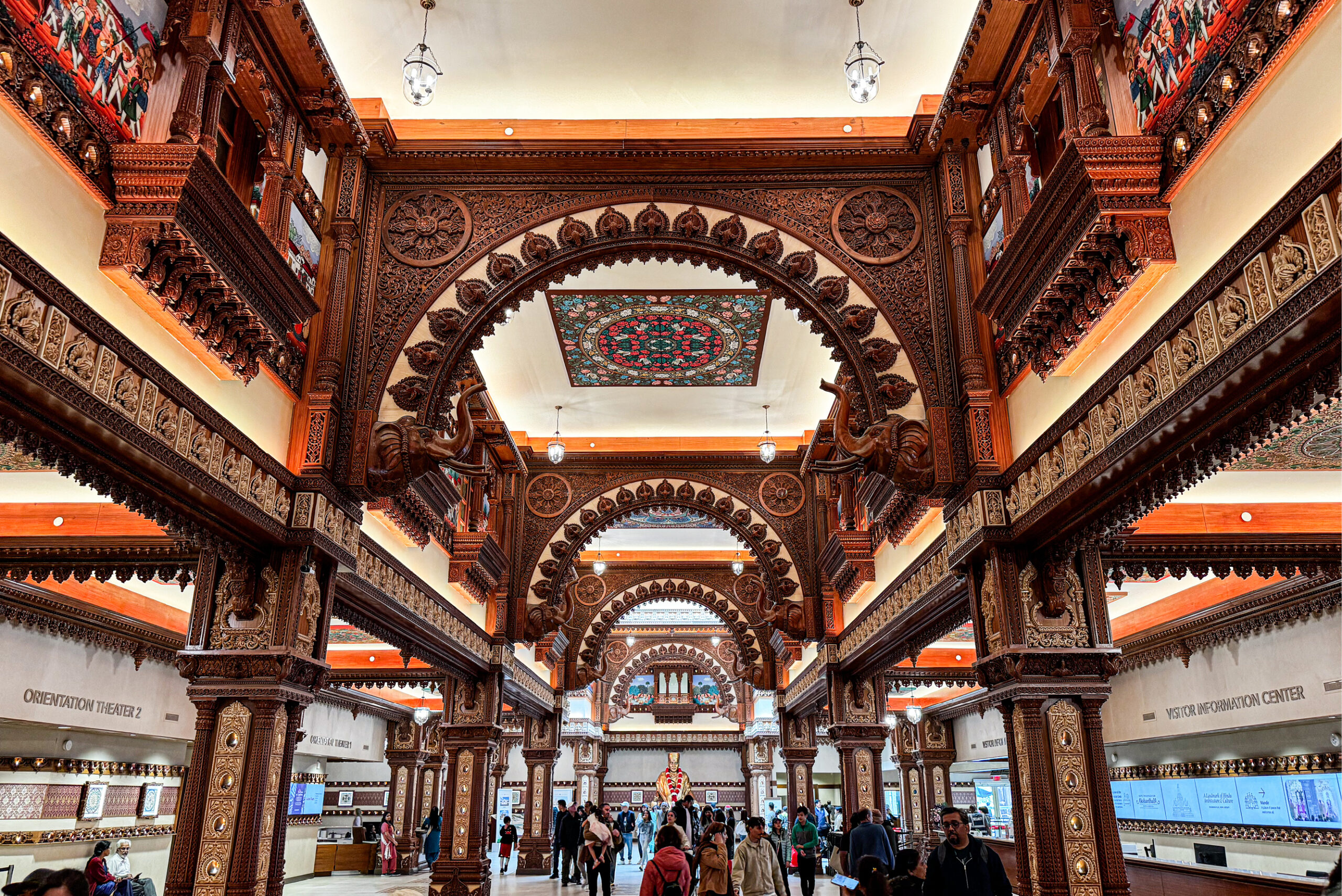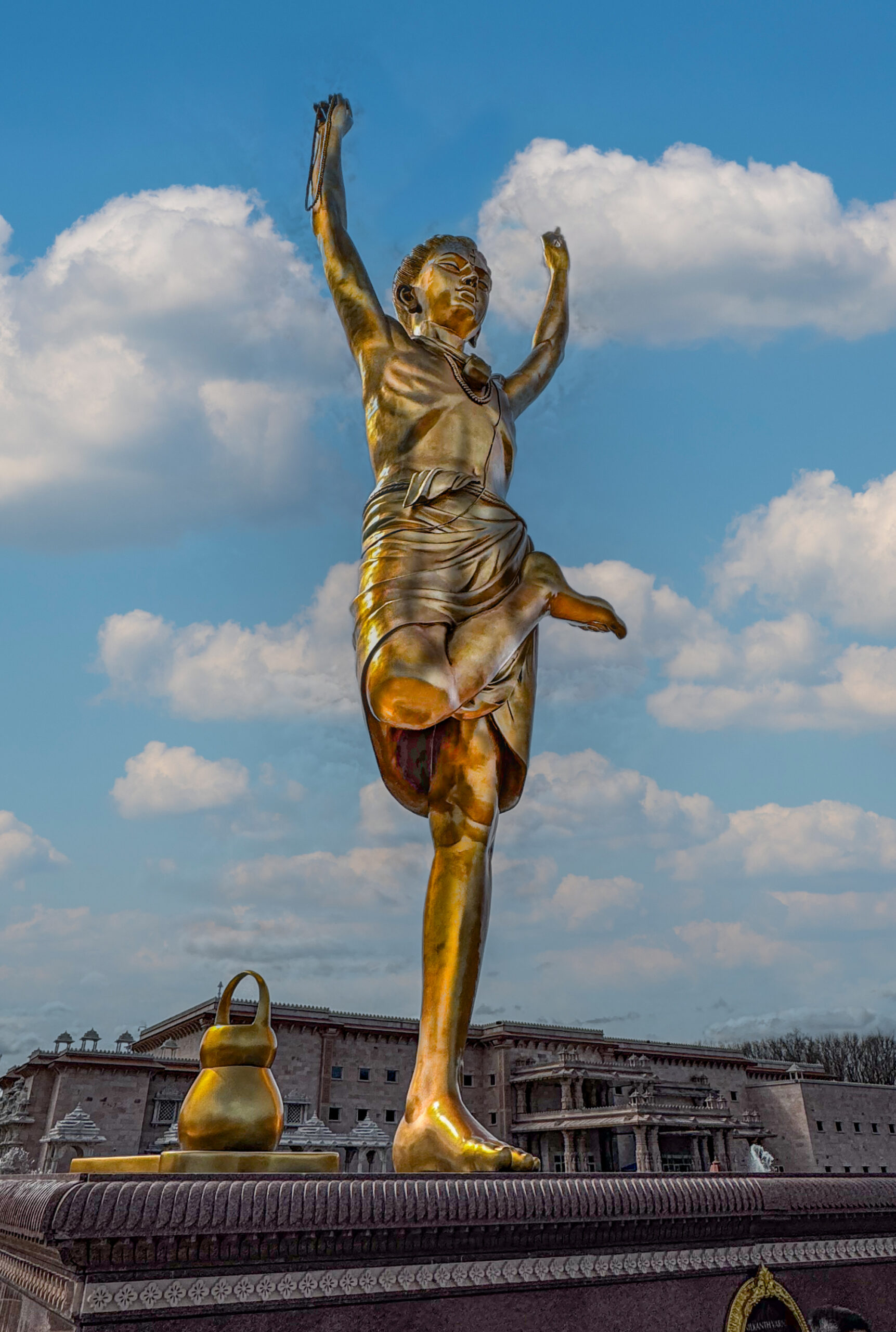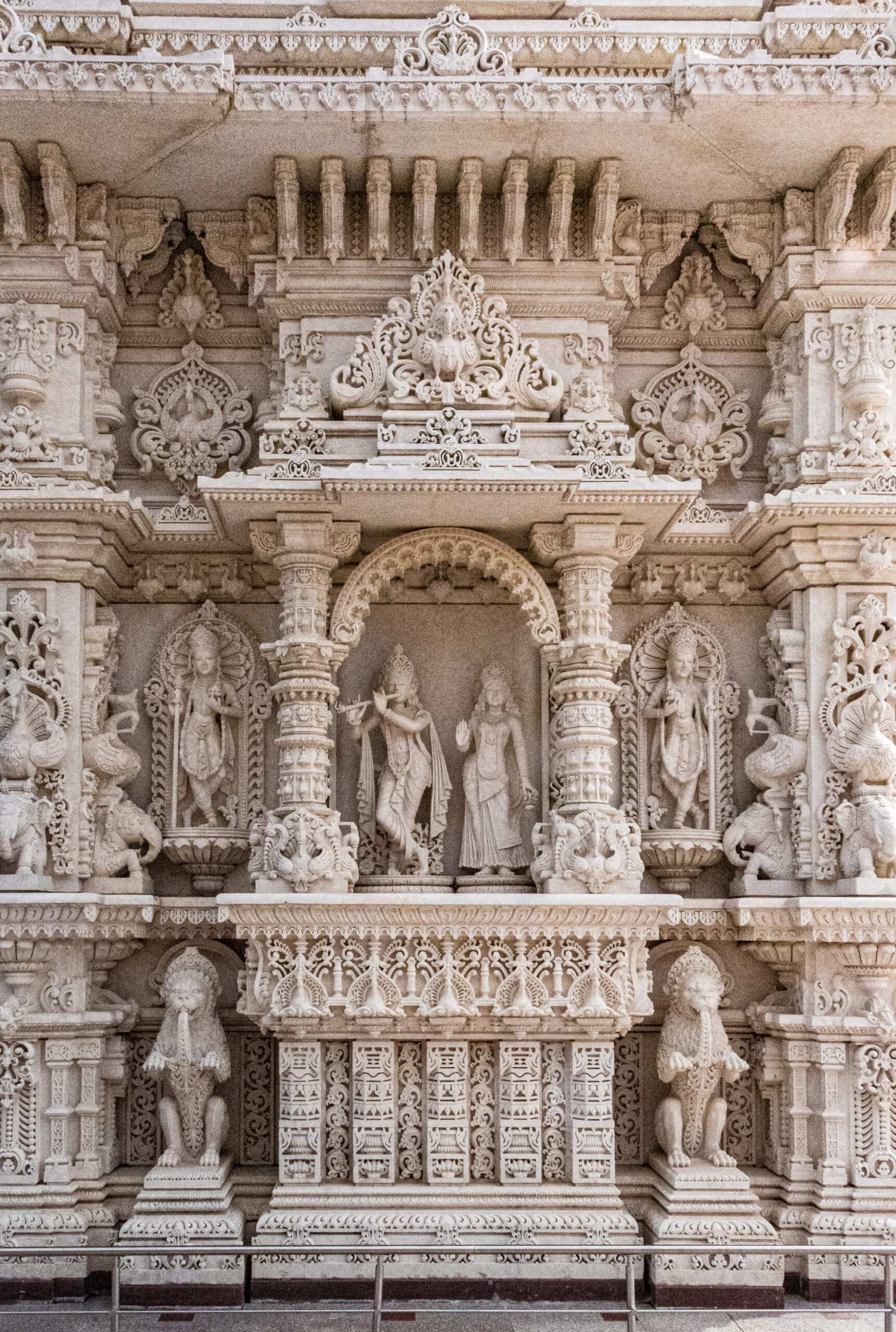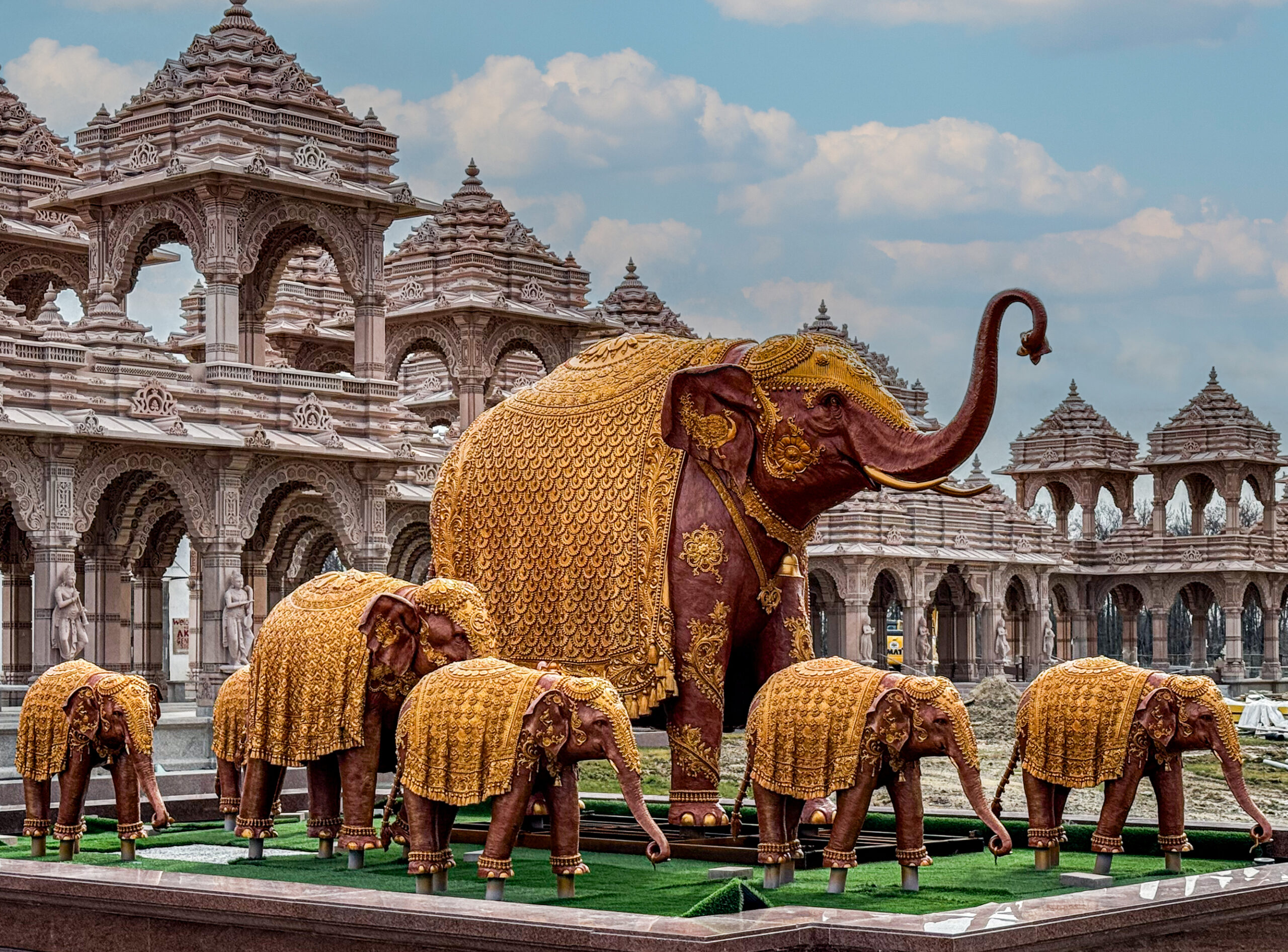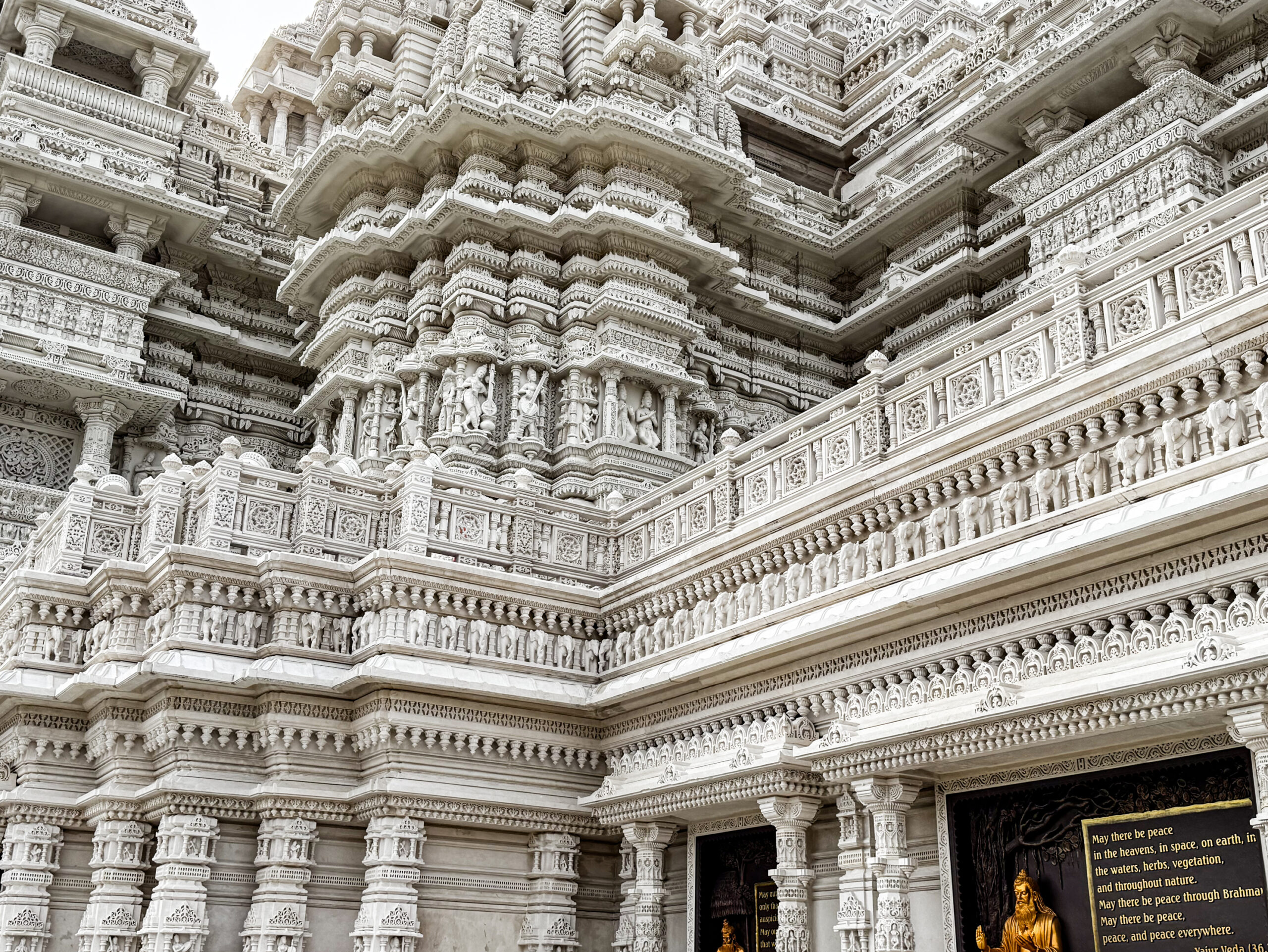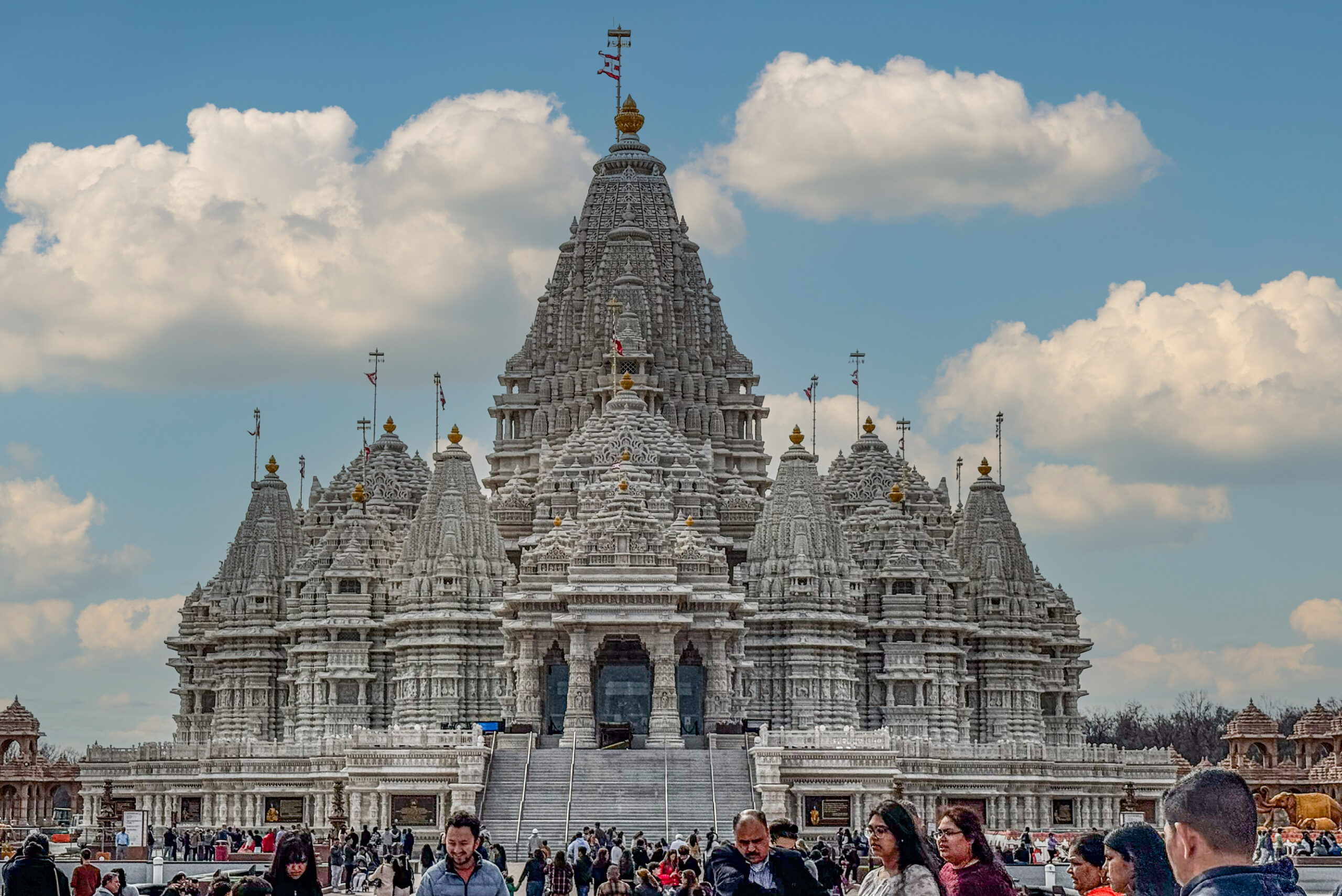Gazing at its majestic monumentality, you might think you’ve been transported to Delhi, India. But this Hindu mandir (temple) is not half a world away. It’s in Central New Jersey’s Robbinsville Township, just a quick one-hour drive from my Center City Philadelphia apartment. And it’s the largest Hindu temple in the world outside India.
Eva, my Bengali friend originally from Kolkata and many times traveling companion with our spouses to India, sent me a New York Magazine story about the temple several months ago, and immediately I put this South Asian architectural wonder on my “must-see” list. What better way to spend Easter Sunday than to visit another religion’s paeon to the Almighty.
The Akshardham Mandir is a Hindu temple campus built by a socio-spiritual Hindu denomination called BAPS Swaminarayan Sanstha, named after their spiritual leader.
Behold an Enormous Hindu Campus
Near the site’s entrance, we thread our way into a train of cars crawling to the vast, mostly already filled parking lot. Out of the car, I turn and the *GASP* moment hits me. The 185-acre Akshardham Mandir campus imposes itself on the otherwise flat surrounding landscape, further exaggerating its outrageous prominence.
A stream of visitors leads us to Nilkanth Plaza at the entrance to the campus, where a 49-foot-tall golden bronze murti (image or statue) of Nilkanth Varni (ideal yogi) in a traditional yoga pose welcomes us. He embodies the spiritual leader Swaminarayan as a young man.
Beyond him, a huge water tank spans the campus’ frontage. Arching sprays from the center of three fountains provides a moving screen for catching a view of the confectionary Mahamandir (great temple) in the distance. Water in this tank and in two pools inside the campus represent 300 sources, including water from each of our 50 states, to symbolize the religion’s openness to the world.
As we join the long line to enter the complex (“Only 20 minutes to enter,” the docent tells us), the sweet odor of incense swirls around us; I look for spray tubes among the lavender plants that fill meandering center beds in the plaza. Standing in the orderly line, I survey the hundreds of guests, most who seem to be of South Asian origin in appearance. A much smaller number have features more typical of people from other parts of Asia. A small percentage represent those of European lineage. I learn later that the state of New Jersey counts 278,000 Hindus in its population, the highest of any state in the union. Twelve Hindu temples are scattered across regional Philadelphia alone.
After a security checkpoint, we enter through the walls of the complex into the Welcome Center, a grand hall ornately decorated with murals, carved wooden elephant heads, columns filled with reliefs, and a large bronze image of the adult Swaminarayan in a seated yoga pose. Photo montages and displays line the sides of the hall. The reception room itself was built in the style of a haveli (a traditional Indian mansion or manor house). If you sign up for a tour (see the If You Go section below), you’ll meet your guide here and probably watch an introductory video, which is not being shown on this holiday weekend.
An exit at the far end puts us at the head of the great plaza. Facing the Mahamandir, a central walkway shouldered by two pools leads to the temple’s grand staircase. Next to the pools on either side, a connected series of pink sandstone gazebos form an arcade that reaches around the extended sides of the mandir. I can imagine the temple’s finely articulated façade is made from giant Lego pieces. It’s a magnificent, almost overwhelming scene, and it demands a stop to inhale its exotic beauty.
Like Rome, this Hindu Temple Wasn’t Built in a Day
First proposed in 1997, the Hindu denomination began construction of the Akshardham campus in 2010, with its consecration and dedication in October 2023. Designed and built according to ancient specifications, 68,000 cubic feet of marble make up the Mahamandir and its smaller mandir sister.
The marble took an interesting journey from ground to building. Mined from quarries in Italy, Greece, and Turkey, the excavated mineral traveled to Rajasthan, India, where hundreds of artisans carved images and motifs. First, engineers assembled and numbered sequentially the completed pieces in workshops. Then they disassembled them and shipped everything to Robbinsville, New Jersey. (I’m sure my puzzle friends would love to have worked on reassembling the pieces for final construction.) Robbinsville also received shipments of pink sandstone and granite from India and limestone from Bulgaria and Turkey.
The campus construction involved a staggering number––12,500 people, mostly volunteers! They represented students, teachers, doctors, architects, and business execs from across the U.S. and Canada, some staying a week, and others, up to a month or more. Most received training in mandir architecture and construction. Additional volunteers cooked and fed the workers.
Splendor of this Exquisit Mandir Envelops Us
We enter the smaller mandir with an intricately carved façade near the Welcome Center. “No shoes allowed, please,” so we deposit our footwear on racks in the shoe room. Situated in the building’s center is another smaller temple glowing an ethereal bluish white. As I follow a roped path that circumnavigates the room, the exquisitely carved images of gods and goddesses seem to come to life. I want to touch them.
Where the path reaches its farthest point before circling back, three sets of closed golden doors present themselves. A small crowd waits. A docent tells us we’re just in time for the doors to open and reveal the images inside. I know from my Indian friends and from my several trips to their home country I’m about to experience darshan.
Hindus believe that once a murti (image) is consecrated, the deity resides inside. When a follower meets the deity’s gaze by staring at the image’s face, they experience darshan, an intimate connection with that being as a form of worship. Through this experience, they gain the god’s blessing.
The concept is uniquely Hindu. Or is it? It doesn’t seem so foreign to practices in Christianity where supplicants beseech images of Jesus Christ, Mary, the Disciples, and a panoply of saints for forgiveness and blessings.
Each open door reveals two golden images dressed in various articles of red finery and jewels. I’m familiar with husband-and-wife team Shiva and Pavarti, and I recognize the monkey god Hanuman. Swamis or monks perform a worship ritual five times daily with these images (waking up, bathing, feeding, and putting to bed), and visitors are able to view them four times daily (see below for times). Try to time your visit to catch a darshan experience.
Mahamandir is Breath-Taking
Back outside, we walk towards the 191-foot-high Mahamandir. I see facades and pillars festooned with otherworldly array of marble-carved dancers, musicians, animals, and cultural motifs. On either side of the grand staircase, a family of elephant statues welcomes visitors. We enter a side door, deposit our shoes, and climb the steps to the grand hall, an opportunity to immerse myself in the richness of the Indian culture.
Walking among dozens of immense columns, carvings of scenes of music and dance, revered sages, saints, and spiritual leaders flood my senses. I look up at the inside of the dome’s 15-foot span to see concentric circles of astrological signs, figures of religious leaders, and sacred Hindu symbols circling the central medallion. I chat with a friendly volunteer docent who’s kept busy reminding people to not touch the marble and to stop taking pictures with their cell phones (photos prohibited!).
What a spectacular finish to this stunning sight-seeing experience.
As we head towards the exit to our familiar world, we pass the requisite gift shop, where the mandir image is printed on tee-shirts or attached to key rings, and other more practical items are for sale. We pass a cafeteria and a store of packaged foods and snacks from the Asian subcontinent. I buy a few different tasty (some spicy!) goodies to take home. Last, an office suite houses the BAPS Swaminarayan Sanstha Foundation that supports the denomination’s many benevolent works in New Jersey and across the country, including tree planting programs, health fairs, and services for the elderly.
Want to enjoy an eye-opening day trip if you’re in the Greater Philadelphia or New York City area? It’s hard to beat a visit to the Akshardham Mandir campus in Robbinsvile, New Jersey. You’ll come away with a new appreciation for the rich culture of Asia’s subcontinent.
If You Go
Getting There
From Philadelphia area: Take 95 N to 195 W to Rt. 130 N. Proceed several minutes to entrance at 112 N. Main Rd.
From New York City: Take 95 S. to Rt. 133 W. to Rt. 130 S. Proceed several minutes to entrance at 112 N. Main Rd.
Entrance fee: None
Hours:
- Open 9:00 am to 7:30 pm daily. Closed Tuesdays.
- Advanced registration now required for holidays and weekends.
- Shrines open for darshan (viewing the images): 9:00 am, 11:15 am, 4:00 pm, and 7:00 pm.
Tours: Private tours available for up to 15 visitors; large group tours also available. See website for details.
Website: usa.akshardham.org

